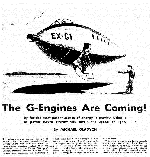On Third Reich Flying Saucers, German Physics, and the Perpetuum Mobile
A Review
Nick Cook, The Hunt for Zero Point, Century/Random House, London 2001, 281 pp. hardcover, £17.99
An Introduction into the Topic
For certain book reviews one must give an explanation and justification in order not to be misunderstood or put in a false light. The review of the book in question here is one of them, because in this book history is only a byproduct, the main concern being revolutionary energy technologies, a subject that is not the main focus of The Revisionist. However, since the historical background falls in the era of the Third Reich and deals with secret weapons research in Germany, the subject will probably be of much interest to readers of TR.
Cook's book is about the suppression of revolutionary physical and technical discoveries by powerful interested parties, which would entail the revision of current knowledge. That this kind of proceeding is familiar to Revisionists is another reason to review the book.
A Personal Introduction
In 1989, I came across a German magazine named Code-now discontinued-which contained a long article on flying saucers supposedly developed by the Third Reich, containing authentic appearing cross-section construction drawings of flying saucers named Hanebu. The article was impressive, but it suffered from the major drawback that it did not contain any references to primary sources or to scientific or technical literature which might have enabled the reader to examine the claims more closely. When I inquired at Diagnosen Verlag, the publisher of Code, I received an answer from the author of the article that did not refer to any primary documents or archives nor to any technical or scientific literature, but merely asserted that one could understand the former German wonder technology only by means of an esoteric frame of mind. My own half-year lasting excursion into esoterics, however, had convinced me that believers in the idea of Third Reich flying saucers were essentially devotees of a religion who wanted to believe rather than wanted to know, and who used a few photographs and construction plans as devotional objects.
In 1993, shortly after my house was searched for the first time by the German Thought Police, I came in contact with a person who subscribed to this religion. He was an ingenuous patriot with little education who held the fixed conviction that the earth was hollow and that the Third Reich and its flying saucers had survived in the interior and was waiting for the right time to return and to liberate Germany. My attempts to explain to him that there were good static and tectonic reasons why the earth could not be hollow were useless-he wanted to believe.
In 1996, during my short exile in Spain, I became acquainted with a German war veteran who was not highly educated, but who had acquired broad, though not very deep scientific knowledge as a former librarian of a scientific library. He professed a comparable belief, namely that the moon was really hollow and inhabited. A little later he even published a book on the subject.

At the beginning of 2000, I received a book manuscript for publication in which the thesis of the hollow earth and a base for Third Reich flying saucers was set out. The entrance to this base was supposedly in Neuschwabenland (New Swabia), a place in Antarctica which had been explored and mapped by a German research team in 1938. When I enquired with the author whether he had any scientific or technical evidence for this base in the Antarctic, such as satellite photos, he sent me what was supposedly a satellite photo of Antarctica showing a hole several hundred kilometers wide with vertical walls many tens of kilometers deep. Aside from the problem that such a deep hole would break the earth's crust and expose liquid magma, there was also the problem that vertical walls of several tens of kilometers high would be statically instable and would doubtlessly collapse, causing earthquakes and volcanic activity such as would be caused by the impact of a giant meteor. That would be the end of all higher life forms on earth.
Why do I discuss this here? The reason is that handling the subject matter discussed in this book necessarily involves a delicate course of enquiry that can easily end in a plunge into the above-mentioned spiritual and social bottomless pits. Nick Cook's book is full of references to his own anxiety and the anxiety of many of the technical people and scientists he contacted that they would be painted as dreamers and idiots by their colleagues and the media if they let themselves become involved in investigations into a tabooed area of science that had acquired a very unsavory reputation due to its historical origins and connection with political fringe groups.
Who is Nick Cook?
In order to forestall the impression that I have gone crazy and lost contact with reality, I introduce the author of the book, which by the way is published not by a hole-in-the-wall publisher, but by one of the most well-known publishing houses in England.
For 15 years or more, Nick Cook, now 42, has written articles on the newest developments in the weapons industry, with emphasis on aeronautics. He is advisor to the worldwide leading journal for weapons and weapon systems Jane's Defence Weekly and editor of the air weapons section of that journal. His articles also appear in many of the larger British magazines, and his commentaries on weapons development and security issues are broadcasted by the large TV companies of the world. He is considered one of the world's foremost experts in the area of military aeronautics.
The English-language science program Discovery Channel broadcasted a two-hour report on the subject covered in this book, written and presented by Cook, in which he introduced the audience into secrets of the US weapons industry of which he had received knowledge or just made educated assumptions.
Cook was educated at Eaton and has received a degree in Arabic and Islamic studies. The author's lack of scientific training is the weakest point of this book, for it leads him to some obvious errors and misunderstandings, which undermines his competence. It is also irritating that Cook does not make any references to source literature, but attempts to allay the reader's skepticism with a bibliography only. However, a search of the Internet showed that this bibliography, short though it may be, should be a good starting point for investigation of the subject.
A Journey Through Time and Space
Nearly 10 years ago, Nick Cook found a journal article by M. Gladych, dating from 1956, at his workplace at Jane's Defence Weekly, which reported on the advanced state of development of gravity motors that would make possible nearly effortless travel and transport based on a technology which suspended the effects of gravity (see illustration). Nothing has come of this, as we all know. Cook was bothered by the article: who had put it on his work desk and why?
What chiefly excited Cook's interest were statements in the article of technical persons in the US aviation industry who were apparently working on a project in the mid-1950s with the purpose to neutralize the force of gravity by means of an electromagnetic apparatus with which one could cause things to float in the air. Was this merely a journalistic hoax, or were leading US airplane manufacturers really working on such a project? Nick Cook tracked down the last one of the quoted technical authorities still living, but his anxious, nearly panicky, refusal to comment made the matter even more irresistible for Nick Cook. What was going on here?
In his book, Nick Cook describes his search for knowledge in this area move for move: In the US archives he found evidence that at the close of the war the US government confiscated German “wonder” weapons technology and brought it to the USA, and that nothing has been heard of it since: beam weapons for antiaircraft defense (apparently lasers) and various kinds of vaguely described flying objects. He found eyewitness reports by US bomber pilots describing unknown flying objects and unusual optical and magnetic effects in German air space near the end of the war.
From diverse but obscure sources it is apparent that the Third Reich was working on the development of various experimental flying devices. Names such as Schriever, Habermohl, and Miethe appear-they were men who worked on secret projects at laboratories located in Bohemia and Moravia. However, this line of inquiry led Cook into the proximity of politically dangerous groups who have cobbled together a substitute religion out of secret weapons development during the Third Reich, so he abandoned it and turned back to investigate the researches made in the USA and Canada after the war.
In the 1950s and 1960s, the Canadian firm Avro conducted experiments with “flying saucers” that were later made public. The experiments were discontinued. But was this all? For example, what can one make of the numerous sightings of unknown flying objects since the end of the war? And do the secret proceedings at the famous-infamous Area 51, the top-secret US air base in the Nellis military test range in southern Nevada, owe anything to the development of new technology that was carried out in Germany in the 1940s?
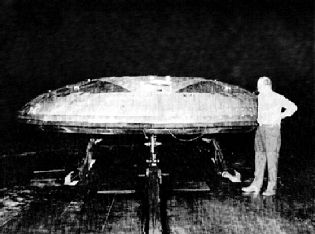
This late 1950s or early 1960s picture is said to be a sub-scale electrogravitics experimental air vehicle mounted on a wind-tunnel test stand[1]
With his excellent connections to the leading US weapons manufacturers, Cook attempted to get a look behind the curtains at the most secret projects under way, at companies and agencies such as Lockheed-Martin, Northrop Grumman, and the NASA Marshall Space Flight Center. He made contact with various aviation and weapons development experts and received the almost conspiratorial support of researchers who, while not giving him useful information, told him he was definitely on the right track.
Revolution in Physics
The weakest point of Cook's book-due to the author's lack of scientific training-is at once its most fascinating: considerations of certain areas of scientific research that could alter our scientific worldview fundamentally, if new theories that were regarded as mere speculations should prove valid. Cook examines some of these areas with the help of a number of scientists. One point is that Einstein's theory of relativity may be in need of correction, since the proposition that objects can not move faster than the speed of light (ca. 300,000 km per second, or 1.08 million km per hour) may not hold.
The breakthrough in physical sciences anticipated for nearly a century with respect to the unification of the four natural forces (electromagnetism, gravity, strong and weak nuclear forces) may be at the point of a practical (partial) realization, because experiments carried out by physicists in the last ten years may prove that gravity can be screened by electromagnetic devices, and thus things placed “above” an electromagnetic field may be made weightless, so as to hover. Even more, one could even speak of a repelling effect here by which an object could be accelerated. The next step might be the generation of gravity beams which could cause things to have weight in certain directions.
There are a number of reasons to believe that our world is built in a way quite different than we have been accustomed to think. According to certain quantum theories, our world does not simply 'exist,' but is formed from the statistical appearance and disappearance of energy and material quanta, the so-called quantum background noise. Should it prove possible to tap this quantum noise (the so-called zero point energy) before it disappears again into nothingness, it would be possible to extract energy quasi out of nothing. What sounds like a perpetuum mobile, or rather, an apparatus that takes energy from the void-which contradicts all physics as now taught (the conservation of energy, the fundamental principle of thermodynamics)-would be relativized, since the theory assumes the existence of parallel universes, so that our 'energy from the void' pump would merely move energy from one parallel universe to another.
Moving faster than the speed of light, levitation, manipulation of gravity, tractor beams, parallel universes, hyperspace, zero point energy: does this all sound like the Star Trek? Yes, and if one believes it is real, that is what our future looks like. That is what Nick Cook thought when he published an article in Jane's Defence Weekly, “Warp Drive When?” (July 26, 2000)
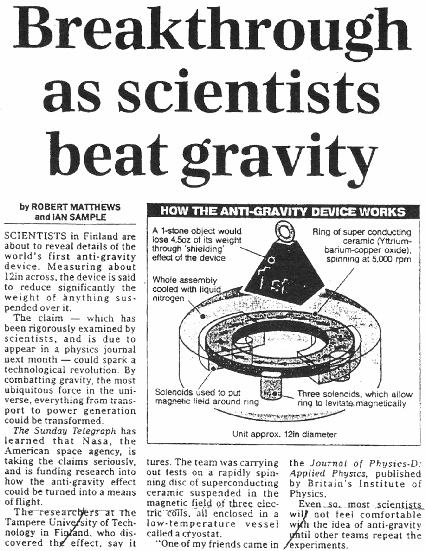
Sunday Telegraph, Sept. 1, 1996
Science or Humbug?
One can easily imagine what our establishment physicists think of all this, as it would turn all physics from the last 2000 years upside down. Yevgeni Podkletnov, a Russian physicist, is one of the leading physicists in the area of “revisionist” physics. When his gravity screening experiments had progressed to such a point that he wished to publish an article in one of the worldwide leading journals for physical science (Journal of Physics D: Applied Physics), it caused an unexpected uproar that caused a set back for the whole project of at least five years. Before the paper was published, Ian Sample of the Sunday Telegraph heard of the new revolutionary research and straightaway wrote a shocking article about it (see illustration) published on Sept. 1, 1996. The term “antigravity” used in this article, which is regarded as extremely unscientific, shed a negative light on the whole project and was devastating. The 'scientific community' launched a flurry of attacks and caused most of the other scientists involved in the project to get cold feet and withdraw their support for the article, leaving Podkletnov out in the rain. Further pressure from the 'scientific community' caused Podkletnov to lose his position at University of Tampere in Finland.[2]
The same thing happened to other scientists who got near this subject: they were made ridiculous by their colleagues, ostracized, often stripped of their honor and dignity, and frequently even having their careers ended. These are behavioral patterns that are only too familiar to Historical Revisionists and explain why Nick Cook found it difficult to draw a technical expert into conversation, since in such matters they shun the media like the devil shuns holy water.
Podkletnov's experiments,[3]
however, were taken seriously enough that even NASA showed interest. Together with the University of Huntsville NASA carried out experiments along the lines Podkletnov had followed.[4]
Also, two of the world's leading aircraft manufacturers, Boeing and British Aerospace, started their own research projects (see illustrations).[1]
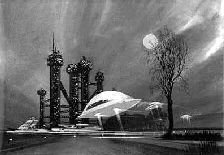

Two BAe Military Aircraft Division's concepts for air vehicles employing anti-gravity.[1]Doesn't this look too familiar?
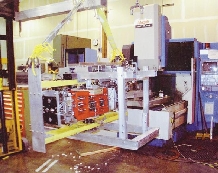
Boeing test stand for gravity test in Seatlle[1]
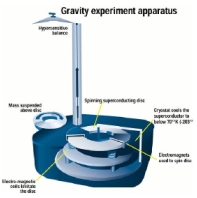
Configuration of gravity modification experiment by Boeing[1]
German Physics
After Cook received an experimental demonstration of 'revisionist' physics that convinced him that he was dealing with serious research, he took up again the pursuit of physics in the Third Reich, which, he believed, would bring him to the origin of the new 'revisionist' physics. Cook's reports on secret weapons research in the Third Reich are, as one might expect in the contemporary climate of opinion, colored with the usual polemic about the
'Empire of Evil,' but one should ignore it. The most interesting part of his investigation brought him into contact with the son of Viktor Schauberger, whose practical researches led to a number of revolutionary technologies, none of which were developed to the point of practical usefulness. Toward the end of the war, Schauberger collaborated on the development of German flying saucers. At the suggestion of a Polish researcher, Cook journeyed to Silesia and inspected a secret research facility whose purpose is now a mystery. Cook speculated on the basis of information he had collected that the site could have been a test stand for a prototype gravity-drive flying saucer (see illustration).
It is true that Schauberger was brought to America at the end of the war by Operation Paperclip, a program to kidnap leading German scientists and to bring them to the USA, but due to his age he had little success in the replication of his research-that, at least, is the official version.
Cook discusses briefly the desperate research conducted by the Third Reich in remote hideaways of science in the face of extremely limited resources in order to find technical solutions to their military problems. This despair had as one result that researchers were allowed to deviate from the accepted theories and to penetrate into areas deemed impossible by established physics. According to Cook, the Germans may have succeeded in developing a technology for screening gravity and maybe even for tapping zero point energy, without being entirely aware of the theoretical basis. Cook is effusively shocked at the possibility that the Third Reich, the 'Empire of Evil,' may have been at the threshold of getting access to unlimited energy resources and transport methods, based apparently on the victory of quantum theory over relativity theory, the victory of applied research over theoretical science, or, as Cook puts it, the victory of 'German physics' over 'Jewish physics,' as it was then polemically called in the Third Reich. What a horror that would have been, indeed!
… But They Hover After All!

A test stand for flying saucers in Ludwigsdorf, Silesia?
Podkletnov has returned to Finland and has recently published an article in which he reports on successful experiments on the generation of gravity beams.[6]
He told Cook in a conversation that he had also succeeded in completely screening gravity from objects, thus enabling them to hover.
It appears that this technology has reached a point where practical applications are possible. Thus, Ning Li, who has done research for NASA at the University of Huntsville, Alabama, has withdrawn from the physics faculty of the University of Huntsville in order to devote herself to applying the results of her research to practical purposes. Cook stated that Podkletnov had received an offer from Toshiba to make his research results commercially useful.
Of course, there are many hangers-on involved here because this area of physics is new and little understood, it is difficult not just for the layman, but also for the technical specialist, to distinguish between serious research and charlatanry (see illustration). It should be kept in mind that specious promises of costless energy should not be lightly believed.
Reactions
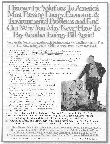
Advertisement for an apparatus that solves all problems at once with the 'new physics.' This may be too much of a good thing.[5] (click to enlarge)
During a telephone conversation, Nick Cook told me what the reactions to his latest book were, which has become a bestseller in England. The book was favorably reviewed in the English daily newspaper The Guardian, in the science magazine New Scientist, and in a number of smaller English daily newspapers. Cook's colleagues at Jane's Defence Weekly were thoroughly approving of his work, and some of them congratulated him on its success. The reaction from the aeronautics and weapons industries was divided. While some rejected his main thesis of the emergence of a new physics, others thanked him for having opened their eyes. The 'scientific community' was also divided. Some of them dismissed Cook's work as nonsense, while others were grateful that he had popularized this interesting and controversial theme and had rescued it from oblivion. The most negative reaction came from a UFO researcher who called Cook a “neo-Nazi” because he said the historical origin of flying saucer technology was in the Third Reich. (UFO researchers want to believe in little green men.) This label is utter nonsense because Nick Cook's opinion of the Third Reich is, as has been stated, distinctly negative.
Nick Cook stated:
“It would be a mistake to disregard the research in Germany in the 1930s and 1940s just because it was done in the Third Reich. This kind of suppression of facts would be unscientific and would be just as bad as the suppression of facts that happened during that era.”
So it may turn out that not only Otto, Diesel, Wankel, Jet and Rocket motors were invented in Germany, but also gravity motors-Nazis or no Nazis.
Notes
First published in German in Vierteljahreshefte für freie Geschichtsforschung, 5(4) (2001), pp. 459-463; translated by Michael Humphrey.
A comprehensive collection of primary and secondary sources on this topic can be downloaded from www.aeronautics.ru/archive/gravity/gravitsapa.pdf (41 MB!). The following internet sites are good places to locate further literature:
www.inetarena.com/~noetic/pls/gravity.html;
www.omicron-research.com/RecDocD/introD.htm.
| [1] | www.aeronautics.ru/archive/gravity/gravitsapa.htm. |
| [2] | Cf. the article in Wired, 6(3) (March 1998); www.wired.com/wired/archive/6.03/antigravity.html. |
| [3] | Evgeny Podkletnov and R. Niemanen: “A Possibility of Gravitational Force Shielding by Bulk YBa2Cu3O7-x Superconductors”, Physica C 203 (1992), pp. 441-444. |
| [4] | Cf. Ning Li and D.G. Torr: “Effects of a Gravitomagnetic Field on Pure Superconductors”, Physical Review D, (1991), pp. 457-459; Ning Li, D. Noever et. al.: “Static Test for a Gravitational Force Coupled to Type II YBCO Super-conductors”, Physica C, 281 (1997), pp. 260-267. |
| [5] | The information given at the website http://www.teslaelectric.com/ is so paltry and concentrates so much on advertising that it does not seem to be worthwhile. |
| [6] | Evgeny Podkletnov, Giovanni Modanese, “Impulse Gravity Generator Based Y Ba2Cu3O7-y Superconductor with Composite Crystal Structure”, http://xxx.lanl.gov/abs/physics/0108005. |
Bibliographic information about this document: The Revisionist 1(2) (2003), pp. 229-234
Other contributors to this document:
Editor’s comments: First published in German in "Vierteljahreshefte für freie Geschichtsforschung," 5(4) (2001), pp. 459-463

